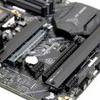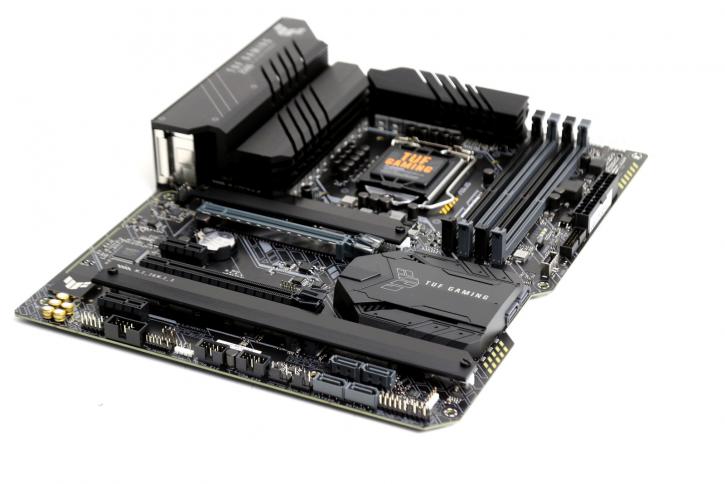Final Words & Conclusion
Final words & conclusion
This TIF Z590 Plus WIFI from ASUS interestingly enough was the last board we tested from the batch we have received, and as such it has the latest BIOS. It is super interesting to see that the performance is spot on with the premium 500 EUR/USD boards. Really that's nice to see as at a price of 229 USD/EUR (and you can find them even a little cheaper in retail), this motherboard surely does offer a lot. The tradeoff made are features, WIFI6E (with that E) is not present, however, the AX performance was through the roof, we'd hit nearly 1 Gbps on a single link 5GHz band, that's just terrific. Yes, you'll also lack Thunderbolt, but does anybody really care? Other than that the VRM design is slightly beefed down with 50A stages, but at a 14+2 phase design even under heft load we'd however just above 50 Degrees C on that same VRM area. Not a problem either.
Being in the more affordable range, the board does not come with an OLED display, there's no 5 Gbps Ethernet LAN, however, applied you still get 2.5 Gbps jacks. Remember though, most Z490 motherboards will be PCIe 4.0 compatible (with Rocket-Lake) after a firmware upgrade. The leaves as the difference an x8 lane uplink from chipset towards the CPU and vice versa, as well as USB gen 3.2. The differences end there, though. ASUS did add four M2 slots; however, one can be connected directly to the CPU at 4x lanes would offer full Gen 4.0 x4 bandwidth. The ones connected through the Z590 chipset are PCIe Gen 3.0 based (for me, no biggy, though).
DDR4 memory
For Rocket Lake-S and 10th Gen Intel procs) and DDR4, we always say, volume matters more than frequency. A 3200 CL16 to 3600 CL18 MHz kit is fast enough overall for all your needs. Higher frequency memory is more expensive and does offer better bandwidth, but the performance increase in real-world usage will be hard to find. Unless you transcode videos over the processor a lot, as always, my advice would be to go with lower clocked DDR4 memory with decent timings, but get more of it. Don't go for 8 GB; get two or four DIMMs, and in total, a minimum of 16 GB. We think the current sweet spot is 3200 MHz (CL14/CL16) or 3600 MHz CL16/CL18).
Performance & tweaking
Temps/TDP remains icky to judge but is manageable when you apply proper LCS. We recommend the same for the more high-end Ryzen 5000 processors as both brands benefit from that nicely chilled heat spreader. At the OC levels for RKL, you are looking at 1.35V and higher needed on that CPU core for a decent tweak; however, pretty similar for AMD, tweaking 8-core or higher processors is more difficult as you are bound to run into core limitations, heat, and there it is again .. power consumption. At 5300 MHz / v1.53, we're passing 450 Watts. That's not sane. All core 5200 MHz / 1.43V draws 410 Watts (PC just CPU under load). With a processor that already runs in that 5 GHz domain, you also need to wonder if you want to tweak it at all, as really, the best configuration is already there at defaults. Regardlessly, if you like to do so, LCS will probably get you to 5.2~5.3 GHz (all cores) depending on ASIC quality, cooling, mobo, and power supply. Tweaking wise you increase the CPU voltage and multiplier, and you are good to go. Another plus for the Intel platform is that over the years, they have been able to refine their memory controllers, pop in anything XMP 2.0, and you have a 98% chance it'll work straight out of the box with high-speed memories. However, the effect of speedier frequency memory is far less significant, so opt volume would be my advice. We'd always suggest going with a nice affordable 3200 or a 3600 MHz kit at low latencies. Currently, we feel 3600 Mhz is the new norm and sweet-spot, though. The infrastructure that Z590 offers is sound and has proven to be reliable and easy to use. But if pricing is a thing, I'd even recommend you Z490 over Z590.
Power consumption
With eight cores, you get a 125 Watt TDP processor. But as explained, it all is a little more complicated these days. Intel applies a secondary power stage where the processor can run twice the TDP value for a pretty long time. That with the IPC increase, Cypress cove cores get the holy grail for added threading performance; however, it makes energy consumption peak with higher values during that long boost. The idle system with a GeForce RTX 3090 installed / 16 GB memory / SSD and the Z590 motherboard hovers at roughly 65~70 Watts. That's okay, really, but the load values are significantly different. When we stressed the processor 100% run, we reach approximately 280 Watts with this 8-core processor (for the entire PC with GPU in idle).
Conclusion
Honestly, if it's a better value than you're after, then the TUF Z590 Plus WIFI has got a lot to offer. The performance levels are close and or similar to the expensive premium boards. The tradeoff is a slightly downgraded product, but it's still really good. One 2.5 GigE jack, WIFI6 opposed to WIFI6E, one M2 less and other than that you can argue the relevance of two dozen USB ports, etc. The product has nice looks as well, in that dark design. The 50A power stages are fine, the 14+2 phases as well. , recommended, of course. I'd have no hesitation if I'd be on the lookout for a Z590 motherboard that's done right and one that's not too expensive.
Handy related downloads:
- Sign up to receive a notification when we publish a new article
- Or go back to Guru3D's front page.



